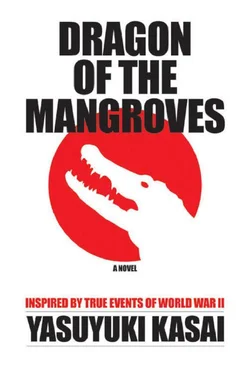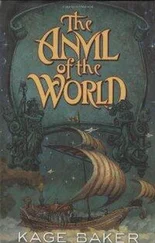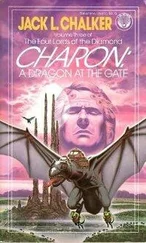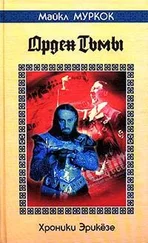“Go!”
Sumi thought back to the supposedly friendly troop in the east ridge. He thought that the soldiers there might have been waiting for darkness, like they had been.
After he had seen the soldiers vanish into the wasteland one after another, Sumi warily bent forward and stepped onto Payadgi-Ramree Road.
6
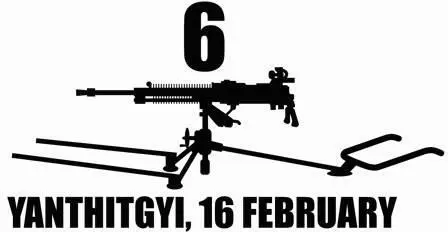
Squatting down in his foxhole at the foot of Yanthitgyi Hill 604, Superior Private Minoru Kasuga intently hulled rice in his helmet. He had gotten this precious rice in a settlement of Yanthitgyi some time before. He had filched it from a farmhouse that had been evacuated and then uninhabited. When the sun set, he had to go down to a stream to wash and boil it with his portable solid alcohol stove.
In Imphal and Guadalcanal, things were in terrible shape. Starvation was rampant, and comrades were driven to the verge of cannibalism. Fortunately, Ramree Island was a rice-producing district. Kasuga had not yet faced such a critical situation. But nobody knew what would come next.
It had almost been a month since this battle had broken out. He couldn’t expect new supplies or provisions anymore, so no one was overanxious for food.
He must collect as much rice as possible and devote what little time he could to boiling it. There was no guarantee that he would have another opportunity to do so.
“Hey, Kasu. Are you still alive?”
With a raucous voice, the stout body of Sergeant Keiichi Tomita fell into the foxhole. Kasuga cautiously lifted up his helmet to save his valuable rice from spilling.
“Keep this with you,” Tomita said and presented a small packet wrapped in oil paper.
“What’s this, Sarge?”
Kasuga opened it and found a brown sooty chip inside. It was a chip of bone.
Hit on his head squarely by an ammunition box blown away by the blast, he had lost consciousness for a while in the Battle of Mountain Maeda. So his memory of their retreat had been somewhat vague. Still, he had clearly remembered Tomita cutting hands off from KIA corpses with a curved billhook called “dah.”
It was a grave matter how to treat remains of war dead. They should either recover remains from a battlefield and return them promptly to his family, or they should cremate them somewhere appropriately, even when the situation didn’t allow full procedures. And they must take back some bones, however few they might be. It was the minimum requirement for the family of someone who devoted his life to the empire.
However, as war casualties piled up, it became impossible to work things out properly anymore. A rumor was going around that bereaved Japanese families were getting cinerary urns containing only a sheet of paper on which the words,
“A Soul of a War Hero,” were written instead of ashes. Those rumors made soldiers very gloomy.
“It’s one of Hirono’s finger bones. I have another, also. I made time and burned his hand to ashes during the retreat. I dug in a small tunnel and burned it there with tapers, so no smoke would be seen. It took time because I had a lot of other guys’ hands. We all lived close. You or me, whichever of us survives, had better give it to his family. Right?” said Tomita seriously.
Kasuga gave a deep nod. He took his hat off for Tomita’s tough sense of responsibility, a reputation he deserved. Kasuga felt ashamed of his rashness, having doubted Tomita’s courage before.
He was reluctant to keep ashes in that seemingly endless war, in which his own death was taking on reality day by day. But he thought he had to do it, for Hirono’s survivors. And it assured him that not only he, but also Tomita, were keeping the ashes.
Tomita Squad had suffered a nasty blow in Mountain Maeda. The shelling had destroyed their machine gun there. It had killed four, including Hirono and the young LMG man beside them, and had wounded many others, as well. It was nearly a total destruction. Kasuga still had a splinter lodged in his right thigh. But Tomita hadn’t even been scratched. Considering the situation around then, it was almost a miracle. Kasuga believed that Buddha had protected his squad leader.
Even if something should happen to Kasuga himself, Tomita would survive and deliver the ashes—not only to Hirono’s family, but also to his own; Kasuga had confidence.
British-Indian forces had mastered the area around Mountain Maeda, and now they were debouching into Payadgi Plain. Mechanized troops were on military roads—improved by the Japanese, quite ironically—and pressing hard toward Ramree Town, the point of strategic importance.
One of those debouching forces had blocked the Japanese line of retreat.
Ogino Platoon had lost Sergeant Ban in the antitank battle and had been led by a young corporal. Together with these Ogino’s men, the survivors of Tomita Squad, including Kasuga, had been kicked into a valley and isolated.
They had been worrying about the future for a good while, when an orderly came to bring them an evacuation order ten days before. According to the order, Tomita Squad was allowed to return to its home unit, Machine Gun Company.
However, neither Kasuga nor Tomita had known where the company HQ were, although they had begun drawing back from Mountain Maeda. They had lost touch with Second Lieutenant Jinno, the platoon commander, since February 4. Perplexed about what to do, they had gotten information from one of the soldiers of Fifth Company overtaking them on the way about a week before. The soldier had said the battalion HQ had completed its retreat and that soldiers had gathered in the all-round defense position at Hill 509, north of Ramree Town.
He had also suggested that Machine Gun Company also might have been there.
An all-round defense position was a stronghold where troops, resolute to die, put up their final resistance. They often called it “hara-kiri position.” That news had immediately put Tomita Squad under extreme tension.
Still called a squad, Tomita Squad had become a small group consisting of Kasuga; Tomita, their leader; First Class Private Tada, their agile and shrewd gunner of short body; and Superior Private Kayama, the only unscathed ammo bearer. The others hadn’t accompanied them because all had been killed or carried to the rear with severe injuries that had not allowed them to walk. Though stretcher bearers had carried them to a field hospital, it probably wasn’t in working order in that upside-down situation. Sufficient medical care was out of the question. Injured men’s hope of evacuating the island alive was very slim.
Kasuga and his colleagues had been resolved to their fate, more or less. But they couldn’t help falling into a dismal mood to learn that fighting to the death was inevitable. When Tomita Squad had reluctantly started moving toward Hill 509 north of Ramree Town, British-Indian forces had already made an incessant onslaught of Japanese rear guard hiding in the mountains around Payadgi-Ramree Road. It had been perilous, so it had taken as long as two days to cut through Payadgi Plain, hiding along the way.
When Kasuga and the others had gotten to Hill 509 five days before, he could see many soldiers squatting in foxholes all over the place.
Kasuga then had heard that Machine Gun Company had taken up its position further east in Letpan Hill 300. It was a place named for its elevation and a village nearby. Nevertheless, without maps, the only thing they could get at the time was its rough location.
After wandering in jungles, they had gotten to Hill 300. Kasuga had heaved a sigh of relief on the spot. Then they had finally spotted MG Company, only to learn it had already prepared for another position change to Saikpya Village, further northeast. So nobody even cared for them, after all. Done enough, they had been lying exhausted on the ground until Second Lieutenant Jinno came out at sunset.
Читать дальше
